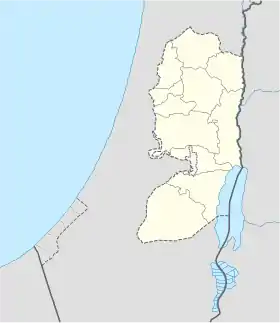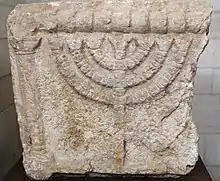 Eshtemoa ruins, 1975 | |
 Shown within the West Bank | |
| Location | West Bank |
|---|---|
| Coordinates | 31°24′03″N 35°04′01″E / 31.400792°N 35.067075°E |
| History | |
| Founded | 4th–5th century CE |
| Site notes | |
| Excavation dates | 1934, 1969-70. |
The Eshtemoa Synagogue, located 15 km south of Hebron in as-Samu, West Bank, refers to the remains of an ancient Jewish synagogue dating from around the 4th–5th century CE.
History

Eshtemoa, identified as modern as-Samu, was an ancient city named in the Bible (Joshua 21:14). During Roman and Byzantine period, Eshtemoa was described as a large Jewish village.[1]
The Jerusalem Talmud (Nedarim 6:10 - Leiden Ms.) recalls a man who lived there, named Ḥasa of Eshtemoa.
Description of synagogue
The remains of the synagogue were identified by L. A. Mayer and A. Reifenberg in 1934,[2] in which site they describe a recess in the wall, once used as a Torah Ark ("Heikhal").[3][4] In 1969–70, a full excavation of the site under the guidance of Ze'ev Yeivin revealed that the building occupied the most prominent site in the village. Ancillary buildings attached to the synagogue were removed in order to reveal the old structure.[5] The old synagogue was built in "broadhouse" style without columns and measured 13.3 m (44 ft) by 21.3 m (70 ft).[6] Entry was by any of three doors along its eastern side and one of the three niches recessed into the northern wall functioned as the Torah Ark. The building housed a mosaic floor and displayed external ornamental carvings.[1] Four seven-branched menorahs were discovered carved onto door lintels and one of them is displayed in Jerusalem's Rockefeller Museum.[7] Along the northern and southern walls of the synagogue were built two benches, one on top of the other, of which only remnants remain.[5]
After the Muslim conquest, the synagogue was converted into a mosque and a mihrab was added.[6][8] The mihrab was built in place of the bench that ran along its southern wall.[5] According to a local tradition, this addition was made during the conquest of Salah a-Din, rather than during the early Muslim conquest of the Levant.[5]
The western wall is still standing to a height of 7 m (23 ft).[6] Many architectural elements of the building have been reused in the modern village.[9]
Near the eastern flank of the synagogue there was built a Crusader church in the 12th-century.[5]
References
- 1 2 Avraham Negev; Shimon Gibson (July 2005). Archaeological encyclopedia of the Holy Land. Continuum International Publishing Group. pp. 167–168. ISBN 978-0-8264-8571-7. Retrieved 29 September 2010.
- ↑ Mayer, L.A.; Reifenberg, A. (1939). "The Synagogue of Eshtemoa - Preliminary Report". Journal of the Palestine Oriental Society (JPOS). 19: 314–326. OCLC 873183425.
- ↑ Press, I., ed. (1951), "אשתמוע", A Topographical-Historical Encyclopaedia of Palestine, vol. 1, Jerusalem: Rubin Mass, p. 26 (folio iii)
- ↑ F.M. Abel, Revue Biblique 35 (1929), pp. 585-ff.
- 1 2 3 4 5 Amit, David (n.d.). "es-Samua'". In Ben-Yosef, Sefi (ed.). Israel Guide - Judaea (A useful encyclopedia for the knowledge of the country) (in Hebrew). Vol. 9. Jerusalem: Keter Publishing House, in affiliation with the Israel Ministry of Defence. pp. 146–149. OCLC 745203905.
- 1 2 3 Günter Stemberger (2000). Jews and Christians in the Holy Land: Palestine in the fourth century. Continuum International Publishing Group. p. 150. ISBN 978-0-567-08699-0. Retrieved 29 September 2010.
- ↑ Léon Yarden (1971). The tree of light: a study of the Menorah, the seven-branched lampstand. East and West Library. p. 151. ISBN 9780852222805. Retrieved 29 September 2010.
- ↑ Nadia Abu El-Haj (2001). Facts on the ground: archaeological practice and territorial self-fashioning in Israeli society. University of Chicago Press. p. 78. ISBN 978-0-226-00195-1. Retrieved 29 September 2010.
- ↑ Raphael Greenberg, Adi Keinan. Israeli Archaeological Activity in the West Bank 1967-2007: A Sourcebook, Ostracon 2009. pg. 136. ISBN 978-965-91468-0-2.